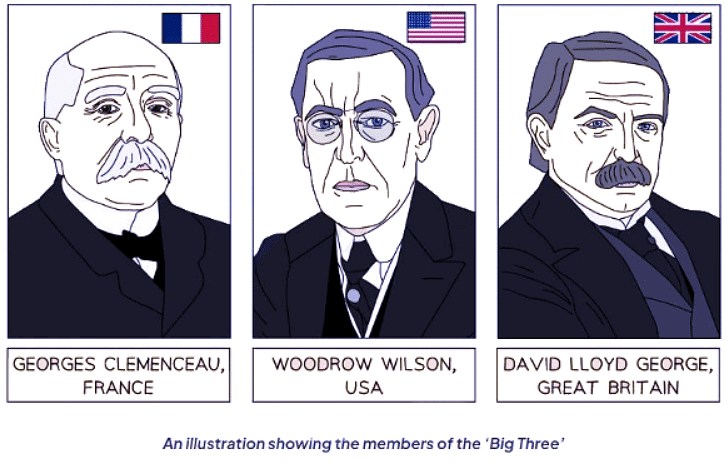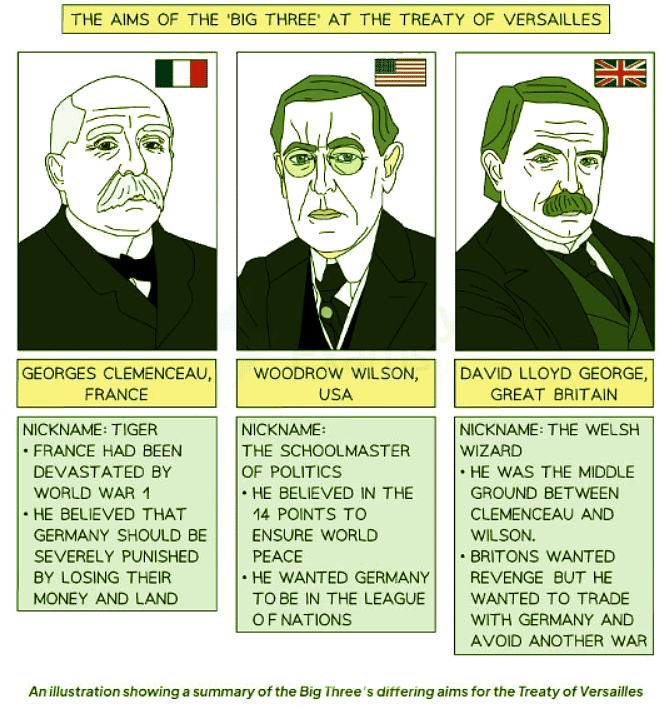Class 10 Exam > Class 10 Notes > History for GCSE/IGCSE > Motives & Aims of the Big Three at Versailles
Motives & Aims of the Big Three at Versailles | History for GCSE/IGCSE - Class 10 PDF Download
Who were the Big Three?
- The temporary peace established by the armistice required a formal peace agreement where the Allies would collectively determine the conditions for the defeat of Germany, Austria-Hungary, Turkey, and Bulgaria.
- Discussions commenced in January 1919 at the Palace of Versailles in Paris, known as the Paris Peace Conference, with the objective of formulating five peace treaties collectively referred to as the Versailles Settlement. Notably, the central treaty, the Treaty of Versailles, primarily addressed concerns related to Germany.
- The 'Big Three'—comprising Georges Clemenceau (Prime Minister of France), Woodrow Wilson (President of the USA), and David Lloyd George (Prime Minister of Great Britain)—were pivotal figures who negotiated the terms of the treaty.

Motives of the Big Three
Georges Clemenceau's Motives
- Clemenceau viewed the Paris Peace Conference as an opportunity to reclaim lost territory, notably Alsace-Lorraine, which Germany had annexed from France during previous conflicts in the 19th century.
- France harbored concerns about potential future aggression from Germany due to their shared border, prompting Clemenceau to advocate for measures to limit Germany's military capabilities.
- Clemenceau's stance was characterized by anger and inflexibility, largely influenced by the extensive devastation wrought upon France during the war. With much of the Western Front located within French territory, the conflict had resulted in significant damage to infrastructure, including roads, hospitals, and factories. Clemenceau demanded reparations from Germany to cover the costs of reconstruction and sought acknowledgment of Germany's responsibility for instigating the war.
Woodrow Wilson's Motives
- Wilson aimed to establish enduring peace following World War I.
- The Versailles Settlement was to reflect his "14 Points," including principles like self-determination for all national groups, disarmament policies, transparent diplomacy without secret treaties, and fostering economic cooperation through tariff removal.
- Wilson envisioned the creation of the League of Nations, advocating for peaceful conflict resolution and universal membership to uphold his 14 Points.
- Wilson advocated for trading with Germany, believing that excessive reparations could weaken the country, while a strong Germany could contribute to Europe's post-war reconstruction.
David Lloyd George’s Motives
- Lloyd George, adopting a pragmatic stance, aligned with certain aspects of France's and the USA's objectives.
- Britain, like France, had suffered significant casualties during the war, fostering a sentiment of vengeance among the British public towards Germany.
- Lloyd George grasped Clemenceau's personal animosity towards Germany.
- Furthermore, prior to the outbreak of the conflict, Germany had posed a challenge to Britain's naval supremacy, while its expansionist policies since 1884 had threatened Britain's imperial ambitions.
- Despite these tensions, Britain supported Wilson's view that a robust German economy would benefit European trade, including with Britain, enhancing the prospects for commercial exchange with its imperial goods.
Question for Motives & Aims of the Big Three at VersaillesTry yourself: Who were the three key figures involved in negotiating the terms of the Treaty of Versailles?View Solution
Aims for the Treaty of Versailles

Key Aims of the Big Three for the Treaty of Versailles
Clemenceau's Objectives:
- Imposition of high reparations on Germany
- Protection of France's borders
- Division of Germany into smaller states
- Demilitarization of Germany to prevent future invasions
- Return of Alsace-Lorraine to France
- Allocation of the Saar Basin to France for economic recovery
- Transfer of Germany's overseas colonies to France
Wilson's Objectives:
- Establishment of independent states with access to the sea
- Return of Alsace-Lorraine to France
- Dissolution of Germany's empire and weakening of all empires
- Avoidance of blaming Germany for initiating World War I
- Inclusion of all nations, including Germany, in the League of Nations
- Advocacy for freedom of the seas
Lloyd George's Objectives:
- Maintaining a robust trading relationship with Germany
- Acquisition of Germany's overseas colonies
- Implementation of terms satisfying British revenge sentiments
- Retention of Germany's military strength to counter potential Soviet influence
- Reduction of Germany's navy to reinforce British naval supremacy
How different were the aims of the Big Three for the Treaty of Versailles?

The document Motives & Aims of the Big Three at Versailles | History for GCSE/IGCSE - Class 10 is a part of the Class 10 Course History for GCSE/IGCSE.
All you need of Class 10 at this link: Class 10
|
81 videos|87 docs|18 tests
|
FAQs on Motives & Aims of the Big Three at Versailles - History for GCSE/IGCSE - Class 10
| 1. Who were the Big Three at the Treaty of Versailles? |  |
Ans. The Big Three at the Treaty of Versailles were Woodrow Wilson of the United States, Georges Clemenceau of France, and David Lloyd George of Great Britain.
| 2. What were the motives of the Big Three at the Treaty of Versailles? |  |
Ans. The motives of the Big Three at the Treaty of Versailles were to ensure peace and stability in Europe, punish Germany for starting World War I, and establish a new world order based on their respective national interests.
| 3. What were the aims of the Big Three for the Treaty of Versailles? |  |
Ans. The aims of the Big Three for the Treaty of Versailles were to create a lasting peace settlement, redraw the map of Europe to reflect the new balance of power, and establish the League of Nations to prevent future conflicts.
| 4. How did the motives of the Big Three influence the terms of the Treaty of Versailles? |  |
Ans. The motives of the Big Three influenced the terms of the Treaty of Versailles by leading to harsh reparations on Germany, territorial losses, and the establishment of the League of Nations to maintain peace and security in Europe.
| 5. How did the aims of the Big Three at the Treaty of Versailles impact the post-war world order? |  |
Ans. The aims of the Big Three at the Treaty of Versailles impacted the post-war world order by reshaping the political landscape of Europe, setting the stage for future conflicts, and establishing the League of Nations as a precursor to the United Nations.
Related Searches





















